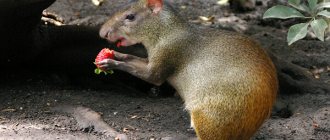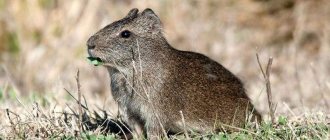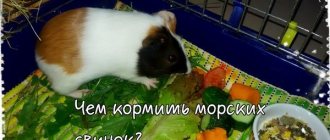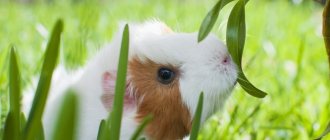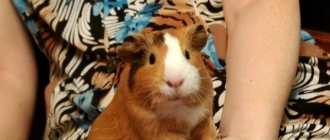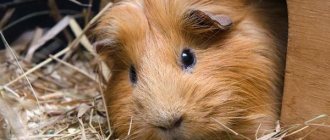Many parents choose a guinea pig as their child's first pet. This is quite understandable, because rodents are easily tamed, quickly remember their name and, if treated well, become affectionate and sociable. But these are not all the advantages of an animal with an unusual name, which in fact has nothing to do with the sea or pigs. There are many other interesting facts about the origin and behavioral characteristics of this cute rodent.
Interesting facts about guinea pigs
- The prehistoric ancestor of the guinea pig, Josephoartigasia monesi, stood one and a half meters tall and three meters long, weighed one ton and had a bite force comparable to a tiger. ...
Josephoartigasia monesi- In the wild, guinea pigs are great at climbing rocks and trees, jumping and swimming well. Their domesticated relatives are slightly less agile. In the wild, they live in packs, almost like prides of lions: a group consists of 1-2 dozen females and a leader male. ...
- Guinea pigs that do not give birth until 6 or 7 months of age are no longer used for breeding. This is due to the ossification of some bones and often leads to the death of mother and cubs. ...
- But the animals are born almost “ready-made”. They are born with open eyes and fur. The cubs are able to drink from a water bottle and can eat hay within a few hours of birth. They spend only three weeks with their mother and are fully mature within three months, although they continue to grow in size until they are about a year old. ...
- Guinea pigs eat their own feces. Unfortunately, coprophagy is essential for the health of guinea pigs. ...
- Rodents sleep little: 10-15 minutes every few hours. ...
- A sleeping animal always has its eyes slightly open, and it can notice the approach of danger even in a sleepy state. ...
- Guinea pigs have dichromatic, rather than full-color, vision. ...
- But guinea pigs have excellent hearing: they hear a range from 54 to 50,000 Hz (compare it with the human range from 64 to 23,000 Hz). ...
- In ancient times, the inhabitants of South America raised guinea pigs for meat and also used them in rituals. ...
- But that's not the weirdest thing! Traditional Indian medicine used rodents as a kind of ultrasound machine for diagnosing diseases. For two hours, the patient was rubbed with a guinea pig (it must be black). After this, the pig was dissected and a human was diagnosed based on the condition of its organs. ...
- Even today in the Andes (where conventional medicine is either unavailable or simply not trusted), guinea pig is believed to cure a number of diseases, including arthritis and jaundice. Treatment includes rubbing the animal on problem areas. ...
- Since the 17th century, biological and medical experiments have often been carried out on guinea pigs. At that time, instead of the expression “guinea pig,” they simply said “guinea pig.” ...
- Guinea pigs usually live about 4 or 5 years, sometimes reaching up to 8. The longest-living guinea pig is considered to be Snowball from Nottingshire (England) - almost 15 years. ...
- The normal body temperature of the animal is 38 degrees. ...
- Guinea pigs cannot tolerate penicillin (and derivatives). Therefore, it is never used to treat them. ...
- There is a myth that guinea pigs get along well with rabbits, which seem to be their relatives. Unfortunately, it is not. In such a mixed company, fights are a common occurrence. ...
The rosette pig surprises with its unusual fur growing in different directions - The animals were called “pigs” because of the sounds they make. Most often it is a cute squeak or purr. The word “sea” actually denotes the overseas origin of the animal. After all, its original homeland is South America. People living in the Andes region domesticated the cute rodent more than 5 thousand years ago. ...
- In the world, the guinea pig is better known as guinea pig, that is, Guinea pig. Ironically, this name is as “fair” as the Russian one. In fact, the animal is found in the swampy areas of Colombia, Venezuela, southern Brazil, and northern Argentina. It is believed that the word "Guinea" comes either from the type of ships used by British traders who brought guinea pigs to Europe, or from the trade route that existed at the time between England, Guinea and South America. Another theory is that the name comes from Guiana, a region in South America.
The cunning of the priests
One of the witty versions of why rodents from South America in Europe were classified as marine animals is associated with the peculiarities of monastic life. According to church beliefs, eating meat awakens base passions and voluptuousness in a person. Therefore, in addition to bread, cereals, beans and herbs, the monks were allowed to eat (with very rare exceptions) only fish. However, many were unable to withstand all the hardships of monastic life on bread and water alone.
A similar trick was later applied to the guinea pig, because there were many monasteries in Germany, Spain, and France.
Features of guinea pigs
Guinea pigs have large and round eyes, so they have a very good-natured look. And this impression is not deceptive. You can even buy such a pet for children. Unlike rats and large hamsters, pigs rarely bite. There are exceptions, but only if the creature is severely tortured. Their distinctive feature is good nature and calmness. Another advantage: guinea pigs are active during the day, so the owners are not in danger of waking up from the noise in the cage. The greatest activity in pigs occurs in the morning and evening.
There are about a dozen different breeds of guinea pigs, which can be classified by their fur, or... lack thereof. They can be divided into four main groups:
- Angora is a guinea pig with long hair;
- Standard - short-haired, with soft fur;
- Wire-haired – the coat feels like bristles;
- Skinny - hairless guinea pig
Population and species status
Residents of South America raise wild guinea pigs to produce meat that has high nutritional value and excellent taste. This means that the enemies of these animals include not only wild animals, but also people. Despite this, the rodent population is not declining, and there is no threat of its extinction from the face of the earth yet.
Guinea pigs are a striking example of the fact that even defenseless small animals can resist larger enemies due to close interaction with each other.
Rodents live peacefully in a group - together they get food, raise their young, and arrange their homes. If threatened, group members notify others of the danger. People could learn a lot from these inconspicuous-looking animals.
What kind of cage does a guinea pig need?
Guinea pigs need a lot more space than most people think. Miniature cages for hamsters and birds will not work here. Experts recommend choosing a “living space” of at least 0.7 square meters per animal. Large cages cannot always be found in the nearest store, but it is quite possible to buy them on the Internet, make them to order, or assemble them yourself. This house should be located in a quiet, secluded place away from large pets and drafts. There should also be no direct sunlight. The bedding in the cage is made from standard fillers of shavings, paper or hay - the same as for other rodents. Do not use softwood shavings (such as pine or cedar) as they are toxic to guinea pigs.
There must be a house in the cage. To make the animal feel even more comfortable, part of the “enclosure” can be closed from above.
Great pets for your home
Many people keep guinea pigs as pets because they are truly cute and friendly little creatures. The more we interact with them, the more they trust us. If guinea pigs sit on your lap, they will often begin to purr and even fall asleep if you care for and pet them.
Some more fun facts:
- In the wild, guinea pigs live in social groups called “colonies.”
- Pet guinea pigs need plenty of attention and love to develop into friendly, lovable pets.
- Guinea pigs are very sensitive to loud noises
- When a guinea pig stretches, it shows that it is relaxed and happy.
- When they are happy, guinea pigs often jump up and down
- Guinea pigs cannot produce vitamin C in their bodies on their own, so they need a diet that contains sufficient amounts of this vitamin.
What to feed your guinea pig?
Pigs love to eat hay, cabbage, lettuce and carrots. Treat them to fruit snacks (such as banana or mango) once a week. You can give raisins twice a week. A healthy guinea pig diet is about 20% vegetables and 5% fruits. But you can’t give bread to pigs. And avoid giving your pet sugary treats or seeds, which can cause gastrointestinal problems. Use moderation: Guinea pigs can become obese if fed too much.
Vitamin C is a key element in a guinea pig's diet. Unlike most other mammals, they, like humans, do not produce it and must obtain it from food. Without vitamin C, guinea pigs develop scurvy. It manifests itself as numerous problems, including swollen joints, lethargy, skin and fur problems, loss of appetite, and more. Therefore, it is important to give the animal the appropriate supplements.
Important fact: Guinea pigs need a lot of roughage to wear down their teeth . A rodent's incisors grow continuously throughout its life, and can become too long in captivity. Therefore, it is important to place apple tree branches or purchased wooden blocks from a pet supply store in the rodent's cage. Otherwise, “neglected” teeth can cause the animal a lot of inconvenience and pain, including refusal to eat. As a last resort, the teeth can be trimmed or removed by a veterinarian, but this last resort should be avoided. By the way, the claws on the paws can also be difficult to grind down in captivity and need trimming.
Physiology
Pigs reach puberty by two months. Cubs are carried for an average of 60–63 days. The peculiarity is that the animals are born already formed: they see, hear and are completely covered with fur. And a few hours after birth, they are already able to move around the cage independently.
The animals' diet is varied. In addition to dry food, the diet includes vegetables and herbs. However, not all products are safe. Before feeding, you should study the list of permitted and prohibited foods so as not to harm the animal.
What is known about guinea pigs is that they periodically eat their own excrement. This happens because a large amount of vitamins K and B remains in the primary feces. To avoid vitamin deficiency, pets instinctively eat waste. Therefore, it is better for owners to buy a cage without a special tray: in this case, the pet will not be able to eat excrement and will begin to suffer from a lack of vitamins.
The teeth of pigs, like those of many rodents, grow continuously throughout their lives and need to be constantly ground down. For this purpose, the animals are provided with wooden products or mineral stones. If this need is ignored, the teeth grow and prevent the animal from eating, which leads to exhaustion.
The pet must follow a feeding schedule. His intestines are designed in such a way that food passes through it only with the help of the next portion of food. In the absence of a second portion, stagnation forms in the gastrointestinal tract.
Underwater rocks
Is it difficult to care for a guinea pig? People who think that smaller animals require less attention than dogs and cats are mistaken. Cages (and often the area around the floor) require constant cleaning. The animals are quite sensitive to air temperature, drafts, stress and quality of food. Long-haired guinea pigs need to be brushed to prevent tangles from forming. Hair matted in clumps can cause real suffering to the animal. Establishing contact is also not easy. Young children will likely not wait many days while taming a pig before holding it. Consequently, the animal will not be happy about this. In addition, some animals never get used to such games and tenderness - this largely depends on their individual characteristics.
Guinea pigs do not like to be alone. They need a companion of their own species with whom they can “talk” , play, or just sit next to them. Communication is so important to their well-being that Switzerland has made it illegal to have just one pig. And if you get pigs of different sexes, one will have to be castrated.
Great pets for your home
Many people keep guinea pigs as pets because they are truly cute and friendly little creatures.
The more we interact with them, the more they trust us. If guinea pigs sit on your lap, they will often begin to purr and even fall asleep if you care for and pet them. Some more fun facts:
- In the wild, guinea pigs live in social groups called “colonies.”
- Pet guinea pigs need plenty of attention and love to develop into friendly, lovable pets.
- Guinea pigs are very sensitive to loud noises
- When a guinea pig stretches, it shows that it is relaxed and happy.
- When they are happy, guinea pigs often jump up and down
- Guinea pigs cannot produce vitamin C in their bodies on their own, so they need a diet that contains sufficient amounts of this vitamin.
Factors influencing life expectancy
The lifespan of guinea pigs at home is influenced by a whole range of different factors. These include:
- breed of animal;
- care;
- heredity;
- nutrition;
- health status.
Each of these factors affects the lifespan of guinea pigs to varying degrees, but they should all be taken into account.
Breed influence
Breed affects the life expectancy of an animal less than other factors. This parameter rather allows the pet owner to determine the initially set deadline. Compared to other rodents, pigs live a long time. But representatives of some breeds, according to generalized data, live twice as long as others
Therefore, it is important to know which category your pet belongs to.
Varieties formed naturally (i.e., in natural conditions) are more durable than those bred artificially (by selection). This is due to the fact that natural selection operates in nature - the survival of the fittest.
There are fifty different breeds of guinea pigs in total. They differ in size, color options and other characteristics. They can be divided into three main groups:
- hairless;
- short-haired;
- long-haired.
Hairless or hairless guinea pigs have the shortest lifespan of all varieties. On average, they live 5 years, but with proper maintenance this period can be extended to 8 years (maximum). This category includes the Skinny breed, as well as the equally common Baldwin. These hypoallergenic varieties appeared through the efforts of breeders. They are completely devoid of fur, as a result of which they easily catch colds. Initially, they lived as long as hamsters, but breeders improved the bred variety, thanks to which hairless pigs got a longer life.
Short-haired breeds, on the contrary, have the longest lifespan. On average, these guinea pigs live to be 7–8 years old. These varieties include:
- American;
- American Teddy;
- Himalayan;
- royal, aka Rex;
- crested;
- texel.
Long-haired pigs live on average 6-7 years, but with proper care they can live longer. Breeds included in this category are:
- sheltie, also known as silkie or snare;
- rosette, also known as Abyssinian;
- Peruvian;
- Coronet
When approximately calculating the time allotted to a pet, you cannot focus only on its breed. There are other factors to consider as well.
Conditions of detention
Keeping an animal at home should not be a “prison” in a cage. In order for your pet to live a long life, you need to provide him with a comfortable existence and sufficient physical activity.
The pet's house should be spacious, the desired size is 40x30 cm per animal. The animal's housing needs to be kept clean - regularly cleaned, changed filler and bedding (they should be chosen of high quality).
In addition to the house, the pet should have an area for entertainment, equipped with tunnels and other toys that will allow the animal not to get bored and not become overgrown with excess fat from lack of exercise. From time to time it is worth letting your pet out for a walk and run around a large area - on the street or at least in the rooms of the house.
There should be no drafts in the room where the animal is kept. The air temperature around the pet should be +18–22 °C. Hairless (hairless) pigs need to be kept in an environment with a higher air temperature - the required value is +22–24 °C.
Breeding
Breeding rosette pigs has its own nuances. The gene that is responsible for the formation of spirals and the rigidity of the cover is dominant. When mating two representatives of the breed, offspring without rosettes may appear if the recessive allele for smooth hair (r) is present in the genotype of both parents.
In addition to the rosette gene, an important role is played by the genetic modifier marked M. If it dominates, then the formation of correct rosettes is suppressed even in the presence of the rosette gene.
In such pigs, instead of normal spirals, the following are formed:
- combs only;
- curls on wool;
- only 2 sockets and one comb.
If the modifier gene is in a recessive state (marked mm), then rosettes of the correct shape are formed. In fact, to breed good pigs, a superficial knowledge of their genetics is not enough. Under the influence of various factors, even purebred animals can produce descendants that are far from perfect.
The rosette pig is mated with a male at the age of 4-10 months, if it weighs more than 700 g. Estrus occurs every 16-20 days. The most favorable time for fertilization is the first 6 hours of sexual heat. It is advisable for the male to make several cages during mating games, then the likelihood of pregnancy will be higher.
The rosette guinea pig carries its young for 63-66 days. There are 3-4 piglets in a litter, less often – up to 6. The more babies in the womb, the shorter the gestation period. The first birth can last 2-3 hours, each subsequent one occurs faster. Rodents are born at intervals of 5-7 minutes.
Caring for rosette pigs cannot be called difficult. Rodents are unpretentious, so they won’t cause much trouble. In response to the care and love of their owner, they will willingly give a lot of positive emotions.
Interesting information
- Guinea pigs live from 5 to 7 years. For comparison, mice, rats and hamsters live about two years.
- These rodents sleep for only 10-15 minutes several times a day. They may fall asleep with their eyes open.
- The height of an adult animal can reach from 20 to 25 centimeters in length, and weight from 800 to 1200 grams. As a rule, males are slightly larger than females.
- Despite having fangs and claws, guinea pigs do not like to bite or scratch. Although if you make them angry, they may bite.
- They are herbivores. These rodents are very fond of vegetables, fruits, berries and herbs.
- Pigs are born with open eyes and short hair.
- The antibiotic penicillin is poisonous for these animals; do not try to treat them yourself, because this antibiotic is part of many antibiotics.
- Rodents' teeth grow throughout their lives.
- Despite the fact that pigs are mammals, the body of an adult is not able to digest lactose (milk can cause indigestion).
- The body of pigs is not able to reproduce vitamin C on its own; it must receive it from food.
How to distinguish a male from a female?
Not every breeder can distinguish a male from a female by genitals. It is especially difficult to determine the sex of a guinea pig if a person is encountering the breeding of these rodents for the first time. But this is quite possible and within the power of every breeder, if you take into account several nuances. So, how to determine the gender of a guinea pig - the main methods are presented below.
According to external signs and shape of the anus
To distinguish a male from a female by external characteristics, follow these steps:
- Carefully take your rodent and place it on your palm; if it does not fit, then hold your pet with your hand behind its back.
- Gently and not forcefully press on the lower abdomen so that the pet does not feel pain. The rodent skin can be moved up. In this case, in a male, you can feel the so-called flagellum, which is the penis. If you pressed on your stomach and it came out, then this is normal. In addition, the boy will definitely have a visible scrotum, located just below the foreskin.
- In the female, by pressing on the tummy, you can see the organ itself, which visually resembles the letter U, expanding towards the lower abdomen. It should also be noted that girls have much smaller genitals than boys.
By the anal sac
You can distinguish a girl from a boy by the anal sac; this method is one of the simplest in practice. To do this, place your rodent with its belly facing up. A boy's anal sac will be large and you will be able to see it clearly. In females, this organ is atrophied.
By litter
You can tell a boy from a girl by the type of litter.
In particular, you need to pay attention to the shape of the animal’s feces:
- The shape of the male litter is slightly bent at the corners and may vaguely resemble an arc with a groove.
- The litter of females does not have such a groove; usually their feces are even in shape.
According to other signs
It is quite difficult to determine the identity of a baby; it is easier to understand the gender of a pet when it has already grown a little. Girls will always behave calmer and friendlier than boys. Males are males to show their dominant habits, sometimes attacking other males. In addition, boys often make sounds characteristic of pigs, similar to purring.
Females mount other pets only during sexual heat, but this period usually does not last longer than one day.
Pay attention to the dimensions of the pet. An adult male will be much larger than a female, in particular, we are talking about his head
The weight of a male can reach one and a half kilograms when living at home; as for girls, they usually weigh no more than 1.2 kg.
Electric models
Beginners should pay attention to more innovative gadgets. They are definitely a little more expensive
But in this case, the price increase proportionally affects safety.
We are talking about a family of rechargeable machines equipped with a rotating head. They do not cut, but grind down the cornea. With this approach, it is almost impossible to harm a dog or cat by catching too much of a nail. The high rotation speed of the tip ensures fast operation, and the low noise level does not bother four-legged patients at all. Any beginner can easily cope with such a mechanism.
Price – 481 – 1,859 rubles.
Some models are equipped with 2-3 heads, suitable for dogs or cats of various breeds and age groups.
After all, the claws of a dwarf poodle are much more delicate than those of a German shepherd. The same applies to young kittens and adult cats - their paws need to be treated with different elements. So, when purchasing a tool for trimming claws, you should consider this nuance.
Cost – 567 – 1,189 rubles.
The final touch is the rotation speed of the device head.
It directly affects the quality of claw grinding. After all, it is necessary not only to cut off the ends, but also to polish the ends so that the sharp edges do not injure the delicate pads of the paws. This operation is best done in a more gentle mode at low speeds. So a machine with gear shifting will come in very handy in this case.
Price – 497 – 1,566 rubles.
I like it I don't like it
Communication
Even though animals are not able to speak with words, they communicate with each other using sounds. Guinea pigs, like many other animals, are fairly easy to understand. And they themselves quickly learn how to make the “breadwinner” understand their needs.
For example, pigs sniffling means that they are anxious or waiting. If this sound is interspersed with a whistle, most likely the pet is asking for food.
Rumbling has many meanings; for a more accurate interpretation, it is necessary to take into account the posture. A satisfied, relaxed pig purrs with happiness. If the tone is higher, and the movements are tense or the animal is trembling, this indicates irritation. Animals that are scared make abrupt rumbling sounds. Animals that feel angry grind their teeth and open their mouths, like lions when they roar.
With closer contact, the sounds of guinea pigs and their movements become clear to the owner, so do not regret the time spent with your pet.
Traditional plastic carrier
Perhaps the most common way to move small animals. Very well suited for long-distance travel, but in a car (and especially on a bicycle) a bulky plastic box is not very convenient.
Among the advantages, we note excellent breathability, ease of cleaning and maintenance, the ability to organize meals while traveling, hygiene, strength and durability.
The disadvantages are determined by the need to allocate space for storing this box and, of course, the outdated design. It is necessary to have such a device in stock, but it is not very suitable for short-term forays outside the city.
Cost – 1,146 – 2,137 rubles.
Himalayan
The Himalayan albino pig has a unique genetic coat color: a snow-white shade with a dark characteristic spot in the nose area. Another amazing feature: the absence of eye pigment, which makes the pupils appear red, although in fact only the blood vessels that create such an unusual color are visible. The ears have an unusual petal-shaped shape. The hair is hard, dense and thick. As the air temperature decreases, its tone changes somewhat towards a darker side. These rodents are afraid of sunlight, so when choosing a place for the cage, take this feature into account. They have a calm, balanced character, making them great for families with small children.
Himalayan
Records
The lifespan of pets depends on the conditions of detention, but on average reaches 5–7 years. The oldest individual lived to be 15 years old.
Despite their dense body mass, pigs are able to run fast. The record was recorded by an English animal named Flash, who covered a distance of 10 meters in 8.81 seconds.
Guinea pig facts regarding records:
- Scottish pig Truffle demonstrated the longest long jump - 48 cm.
- Pukel, an animal from Switzerland, jumped 20 cm in height.
- The maximum number of cubs in one animal pregnancy reached 17.
Sports achievements and amazing specimens
Records
In addition to the generally accepted facts of extraordinary abilities, the guinea pig surprises with its sporting achievements.
The rodent Truffle from Scotland jumped into the Guinness Book of Records in 2012, leaving his rivals far behind, and securing the long jump bar. His record was 48 cm.
Swiss Pukel earned the title of champion in high jump, having overcome the value of 20 cm.
It is difficult to imagine how such a well-fed body can set world records, but the facts speak for themselves.
Unusual species
But if we do not take into account the merits of champion pigs, this type of rodent still makes the heart beat faster and evokes an indomitable desire to pick it up, feeling the softness of the fur coat and the heaviness of the body. The beauty and unusualness of some specimens is amazing, and you can’t help but wonder how generous Mother Nature is:
- Dalmatian. A very active animal with a funny coat color that resembles a dog breed. A smart, playful animal that requires daily exercise and exercise to develop physical fitness.
- Baldwin. A young but proven breed of rodents.
Sports achievements and amazing specimens
Records
In addition to the generally accepted facts of extraordinary abilities, the guinea pig surprises with its sporting achievements.
The rodent Truffle from Scotland jumped into the Guinness Book of Records in 2012, leaving his rivals far behind, and securing the long jump bar. His record was 48 cm.
Swiss Pukel earned the title of champion in high jump, having overcome the value of 20 cm.
It is difficult to imagine how such a well-fed body can set world records, but the facts speak for themselves.
Unusual species
But if we do not take into account the merits of champion pigs, this type of rodent still makes the heart beat faster and evokes an indomitable desire to pick it up, feeling the softness of the fur coat and the heaviness of the body. The beauty and unusualness of some specimens is amazing, and you can’t help but wonder how generous Mother Nature is:
- Dalmatian. A very active animal with a funny coat color that resembles a dog breed. A smart, playful animal that requires daily exercise and exercise to develop physical fitness.
- Baldwin. A young but proven breed of rodents.

